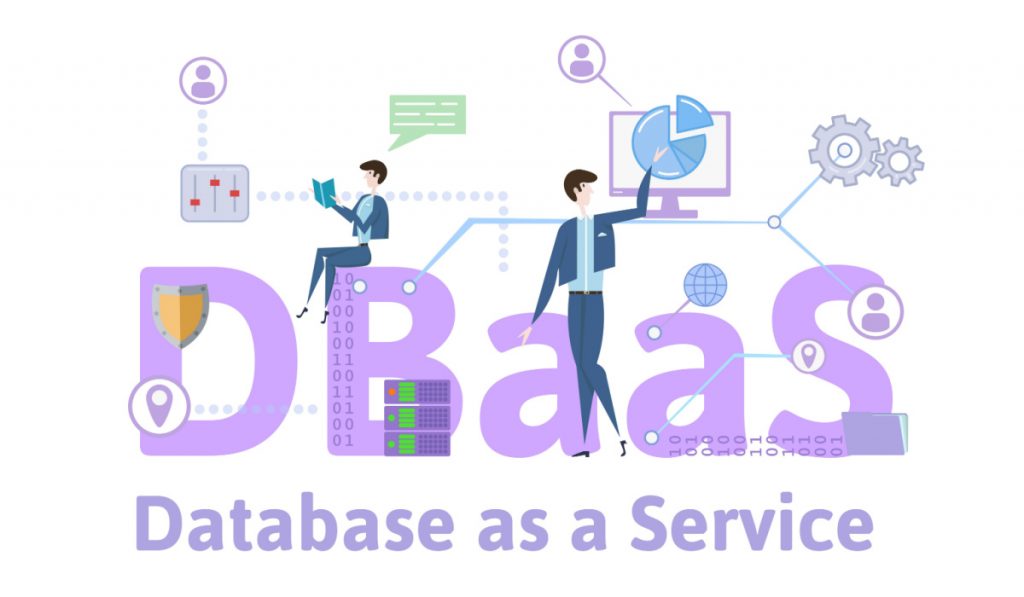Highlights:
- The integration of DBaaS has been gaining traction with multiple organizations switching to cloud databases from on-premise systems.
- The small and medium-sized enterprises that don’t have reliable IT operations can prefer DBaaS model as an ideal option.
Database-as-a-Service
Database-as-a-Service (DBaaS) is a cloud computing service that allows users to access and utilize cloud database system without spending and installing individual hardware system. They can manage the database all by themselves by integrating own database software. The cloud service providers look after frequent updates, backups, security, and 24/7 availability of database systems.
Cloud databases and DBaaS are surging rapidly among the Software-as-a-Service (SaaS) markets, anticipated to hit USD 320 billion by 2025. Users can enjoy multiple benefits of cloud computing in terms of search, storage, access, and applications. This is because, the data warehouse vendors have integrated cloud service providers to avail hosted software versions.
The adoption of DBaaS has been gaining traction with multiple organizations switching to cloud databases from on-premise systems. Although DBaaS operations are compatible with public cloud infrastructure, a few cloud providers integrate DBaaS technologies in on-premise data centers to remotely manage for the customers in hybrid cloud infrastructure.
How is DBaaS Different from On-premise Database?
The database server, in on-premise computing domain is an integral part of organization’s IT infrastructure and is indigenously managed by the company’s own IT staff. Besides, a database administrator (DBA) handles and configures the databases running on server.
Contrary to this, in DBaaS model, the system infrastructure and database are maintained by provider as a fully managed cloud service. The database installation, high-end administrative functions, maintenance, configuration, and upgrades are covered under the service. Moreover, miscellaneous activities including patching, performance management, and backups are also coordinated by the provider.
Benefits
DBaaS offers surplus advantages as compared to on-premise database management system in terms of operations, strategies, and finance. The legitimate benefits of the service are as follows:
- Flexibility: Users can immediately facilitate additional storage and operational capacity during run time if required. They can scale down the database cluster during redundant usage times to save on expenses.
- Negating Physical Infrastructure: The supporting IT infrastructure to run the database is offered by the DBaaS vendor or cloud platform provider hosting the DBaaS domain, if the organizations are different.
- Price Management: Infrastructure creation for database management is an expensive affair, while leveraging it whenever required is also costly and often not thathelpful. DBaas helps organization to pay just projectable regular charges as per the services used. Spending on supplementary capacity for hypothetical future requirements is negligible.
- Easy and Cost-effective Management: The on-premise database management is a function of in-house administrative team. However, when it comes to managing the DBaaS, the cloud provider maintains everything. Thus, it is observed that DBaaS alleviates the burden of service and administration on IT personnel, allowing them to focus on operations and applications.
- Application and Data Security: Cloud providers generally provide business oriented security with safety features such as default data encryption during transit or at rest, identity integration, and access management variables. They work adhering to particular regulatory compliance standards.
- Quicker Time-to-market and Developments: In on-premise DBMS, the operational teams request access through IT and the development might require days or weeks to process. On the other hand, with DBaaS, developers can autonomously work on database capabilities and configure and integrate the database with applications in minimal time.
- Software Reliability: The prominent cloud service providers provide a pool of advanced configurable DBaaS options with reliable quality. As a result, users don’t have to hover over thousands of different databases.
- Risk Mitigation: Major cloud service providers offer a Service Level Agreement (SLA) ensuring a specific amount of operational time. In case of undesirable events where the provider couldn’t fulfill the requirements specified in SLA, expenses would be reimbursed to the user for any additional downtime encountered.
DBaaS Selection
A range of DBaaS options available includes Relational Database Management Systems (RDBMs) and non-relational or NoSQL databases comprising column stores or documents. Finding the most suitable option for the business involves identifying compatible database technology for applications. Following criteria helps to find the right fit for your enterprise solutions:
- Database’s Suppporting Infrastructure
Its crucial to find a database engine that will leverage to meet the future application requirements along with being compatible to the system’s existing operations. Even the decentralized systems are tedious to manage, maintain, and build as compared to single-node systems. Besides, their flexibility may incur the cost of existing performance features.
- Compatibility of Primary or Auxiliary Data Stores with Applications
Primary data stores offer scalable data models such as document-based data stores and relational databases. They generally support SQL implementations and data modeling tools while emphasizing data integrity. Such flexibility makes them a suitable choice of multiple operations. On the contrary, auxiliary data stores can perform specific specialized tasks but are not concrete general-purpose tools. They offer limited data models and capabilities but deliver best performance in specific domain.
Auxiliary data stores are often recommended if found compatible with existing application requirements. Otherwise, it is advisable to stick to primary data stores.
- Database’s Performance During Testing
The integration of features and capabilities of database with application can be understood only after real-world testing. Creating and exploring a prototype must be an essential part of selecting database. Users should analyze the response time when application sends real-time requests to the database and observes it to process them with multiple operations and traffic that it’ll face in operations.
Uses of DBaaS
The small and medium-sized enterprises that don’t have reliable IT operations can prefer DBaaS model as an ideal option. Outsourcing the maintenance and service of database to some DBaaS providers helps these businesses to integrate systems and applications that are little expensive to build and sustain on premises.
Earlier, most of the DBaaS adoption in large-scale organizations was confined to less crucial operations, such as pilot projects and developments. However, it is evident that even mission-critical workloads can also run on cloud services. The survey of considerable number of cloud users revealed that 49% organizations use relational database cloud service while 38% relies on NoSQL database services.
DBaaS nullifies the requirement of hiring and training the team for database management. The database for instance can be controlled through with the help of management dashboard and an API. Complex processes such as specification and provisioning are facilitated with dashboard’s one-click operations.
DBaaS allows users to operate a database with common set of primitives (abstractions) without implementation requirement. Irrespective of the database type in use, a developer can integrate database instance with the same set of API calls. DBaaS model also offers easy operation for activity tracking, schemas creation, access granting, and adding users.
Challenges of Using DBaaS
Despite equipped with numerous features and advantages, some potential discrepancies of DBaaS as compared to on-premise database are as follows:
- Organizational Control: Deteriorating control over IT infrastructure has been a critical issue with DBaaS. With all databases being managed, the IT personnel don’t have much to control and coordinate over the servers and storage devices. They have to depend on cloud providers for effective infrastructure management. In case if the cloud provider faces a system failure, the organization cannot access its database until the issue is resolved.
- Safety Concerns: Since the system security is monitored by DBaaS provider, the organization cannot have direct control over the servers executing database. Its only under the shared responsibility model for cloud security, where the enterprises can influence a few aspects of data security. However, the cloud service vendor still remains in charge of monitoring the database platform and supporting infrastructure.
- Latency: With DBaaS integration, the system becomes prone to latency. The delay caused to access enterprise data over the internet can lead to performance issues that surge while executing large data volumes.
- Vendor Lock-in: Once the organization deals with a specific cloud service provider, it becomes complicated to move the infrastructure to a different cloud service. Hence, enterprises must pay attention to the service structure of their respective DBaaS provider, so that the enterprise can freely make some changes in the future with less dependency on cloud provider.
- Later-stage High Expenses: Although the initial investment of hosting services for deploying database is affordable, the costs surge as the service needs to grow. The enterprises should deploy only the minimum services required without overprovisioning, as it may lead to higher expenditure.
- System Susceptibility: Despite the reliable security of the cloud infrastructure from vendors, it is still evident that no system is entirely immune to attacks. Hosting crucial data online might lead to the chances of data breach. To cope with such security concerns, an elaborative cloud security policy must be communicated to all application developers. Most data breaches often arise due to human error.
Conclusion
After evaluating the benefits and challenges of using DBaaS, organizations can determine to thrive on the technological shift prevailing in the market. Among the two options available – on premise and Cloud DBaaS, most companies prefer DBaas as a suitable choice for their entrepreneurial operations. Various database engines can be provisioned and managed with the help of common set of API calls that can assist and standardize the system process.













